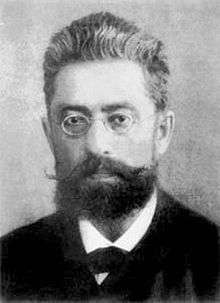Victor Kandinsky

Victor Khrisanfovich Kandinsky (Russian: Виктор Хрисанфович Кандинский) (1849, Byankino, Siberia - 1889) was a Russian physician, and was 2nd cousin to famed artist Wassily Kandinsky.[1] He was born in Siberia into a large family of extremely wealthy businessmen.[2]
In 1877 as a military physician in the Balkans during the Russo-Turkish War, he began experiencing mood swings and hallucinations. Kandinsky performed self-diagnosis, and he referred to his mental condition as Primäre Verrücktheit (primary paranoid psychosis)[3] which has been anachronistically translated into modern terms as a "schizophrenic-like state".[4] In 1885 Kandinsky published a book written in German on "pseudohallucinations" in which he describes and details hallucinations largely based on his personal experiences.[4] In September 1889, feeling that his psychotic symptoms were returning, he took his own life by taking an overdose of morphine.[2] He died as a patient in the institution he had formerly run as the medical superintendent, the St. Nicholas Asylum in St. Petersburg.[4]
In a monograph published posthumously in 1890, Kandinsky described a condition which involved being alienated from one's personal mental processes, combined with delusions of being physically and mentally influenced by external forces. The syndrome he described is now known as Kandinsky-Clérambault syndrome, named along with French psychiatrist Gaëtan Gatian de Clérambault.
References
- ↑ . Kandinsky family tree, 6th generation. (In Russian). Access date 2011-09-14
- 1 2 Lerner, Vladimir; Witztum, Eliezer (2006). "Victor Kandinsky, M.D., 1849-1889". American Journal of Psychiatry. 163 (2).
- ↑ Scharfetter, Christian (1983). "Schizophrenia". In Zangwill, O. L.; Shepherd, Michael. General psychopathology. Cambridge, UK: Cambridge University Press. p. 44. ISBN 0-521-23649-5.
- 1 2 3 Berrios, German E. (1996). The history of mental symptoms: descriptive psychopathology since the nineteenth century. Cambridge, UK: Cambridge University Press. p. 55. ISBN 0-521-43135-2.
External links
- Lerner, Vladimir; Witztum, Eliezer (2006). "Victor Kandinsky, M.D., 1849–1889" (PDF). American Journal of Psychiatry. 163 (2): 209–209. doi:10.1176/appi.ajp.163.2.209. Retrieved 22 November 2013.
- Catharina Bonnemann: Biography of Victor Khrisanfovich Kandinsky in: Biographical Archive of Psychiatry (BIAPSY).